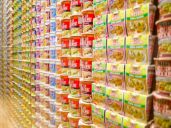The cheap and convenient counterpart
Many people may know this product. It is often seen as a cheap and easy meal. It is widely available in the supermarket, and there are even more kinds available in Asian stores: instant rāmen.
Instant rāmen was developed by Taiwan-Japanese Momofuku Ando by dehydrating the seasoned and steamed noodles in 1958. It became popular quickly and was dubbed “magic rāmen”.
In the early ’60s instant rāmen with separate packets of flavoring powder was launched because there was a strong demand for better quality and taste. Entrants on the market rapidly increased and fierce competition followed. In 1964 the forerunner of the Japan Convenience Foods Industry Association was founded which strove to maintain product quality.
The saturated market was boosted when “CUP NOODLES®” was launched in 1971. What made this type of instant rāmen different is that flavored noodles together with freeze-dried condiments were placed in an upright Styrofoam container. The cup combines three different functions: packaging while in-store, cooker when boiling water is added, and a bowl for eating the noodles.
Notably, due to the rise of income in developing countries in the ’90s, consumption increased quickly. From around 15 billion servings in 1990, the demand grew to over 100 billion servings in 2012. The rapid growth was credited to the five principles of Momofuku Ando when developing instant rāmen: affordability, safety and hygiene, convenience, palatability, and long shelf life. [Cf]
With instant rāmen being affordable, convenient and produced in large quantities, what happens to all the plastic that is wrapped around the actual food?


](https://micrio.thingsthattalk.net/UXWKW/views/max/128x128.jpg)
